Overview
- Brief Narrative
- One of a series of pencil drawings created around 1970 by Hannah Messinger based upon her experiences as an inmate in several concentration and labor camps from 1941-1945. It depicts a seated old woman flanked by a woman and girl. In December 1941, Hannah, her husband Karel Kohorn, and her family were deported from German-occupied Prague to Theresienstadt labor camp. Hannah had an abortion to avoid deportation to Poland. In September 1944, they were deported to Auschwitz-Birkenau concentration camp. That January, Hannah was transferred to Sackisch and then Merzdorf forced labor camps. On May 8, 1945, the Soviet Army liberated the camp. Hannah walked to the Czechoslovak border where she collapsed; her friends took her to a hospital where she was placed in a crib because she only weighed 70 pounds and they thought she was a child. Upon her release, she returned to Prague and learned that all her family members were murdered. Hannah emigrated to the United States on December 21, 1946.
- Artwork Title
- Three Generations
- Series Title
- Last Journey
- Date
-
depiction:
1941-1945
creation: approximately 1970
- Geography
-
creation:
Chicago (Ill.)
- Credit Line
- United States Holocaust Memorial Museum Collection, Gift of Hannah Messinger
- Markings
- front, lower left, stamped : symbol within illegible text
- Signature
- front, right of center, pencil : H MESSINGER (M overlaps H)
- Contributor
-
Artist:
Hannah Messinger
Subject: Hannah Messinger
- Biography
-
Hannah Lowy was born on October 16, 1920, in Carlsbad, Czechoslovakia (Karelovy Vary, Czech Republic) to Emil, born August 14, 1888 and Irma, born February 22, 1893. Emil was an accountant and part owner of a linen store. A sister, Gerti, was born on October 5, 1923. They were an assimilated Jewish family, but observed major holidays. Hannah spoke German at home and school but also spoke Czech.
By 1936, there was a large fascist, pro-Hitler party in Carlsbad and Hannah felt the growth of antisemitism as non-Jewish friends stopped socializing with her. The Munich Pact of September 1938 approved Hitler’s annexation of the Sudetenland, which included Carlsbad. The family moved to Prague. Emil sold linens and painted figurines and Hannah did office work. Hannah and Gerti had to shop for the family, since her parents spoke only German and were treated with hostility.
On March 15, 1939, Hitler invaded Bohemia and Moravia, which included Prague. Hannah had to wear a Star of David badge on her clothes which made her feel like a criminal. Around this time, her fiancé, Karel Kohorn, born on November 13, 1913, in Stiedra, joined her. Hannah was fired from her job as a hairdresser because she was Jewish. She did hair at home and worked as a cleaning lady. The couple married in March 1940.
In 1941, the Germans began to deport Jews to concentration camps and ghettos. Hannah had maternal aunts in the US, but visas were not available. On December 4, 1941, Karel was deported to Theresienstadt ghetto-labor camp, established in November about thirty miles from Prague. Two weeks later, Hannah was deported there. Her father told her to return to the Prague apartment if she was released and made her memorize her aunt’s Chicago address. She saw Karel when she arrived, but he motioned for her to stay quiet. She was placed in the Dresdner Kaserne barracks and shoveled coal and carried potatoes, which she sometime stole. Karel worked in the kitchen, sometimes sneaking her notes or extra food. Orders were issued for women to cut their hair, and Hannah got the job. Occasionally, a non-Jewish friend pushed food and notes from her family through the fence to her. In May 1942, her parents arrived, but, three days later, were transferred to Chelmno death camp. His sister’s fiancé arrived and told Hannah that Gerti was in Poland as forced labor, digging ditches, and was ill. Hannah contracted scarlet fever, then rheumatic fever, and was quarantined. On June 11, Karel was part of a thirty man work detail sent to Lidice to dig mass graves following the German SS massacre. After his return, he and Hannah lived together in an attic. Hannah got pregnant, but had an abortion to avoid being deported to Poland.
On June 23, 1944, the Red Cross visited the camp. Plays were presented and Hannah did the performer’s nails and hair. On September 28, 1944, Karel was transferred to Auschwitz-Birkenau. Two weeks later, Hannah was sent there. During the march to the barracks, she threw her wedding ring and watch in the mud. A female prisoner shouted to throw bread over the fence; Hannah threw hers; the woman caught it, and was shot. Hannah was stripped, shaved, searched for contraband, and showered. She was given a shift and wooden clogs. She slept on a wooden plank with 5 others and used a wet rug as a blanket. She stood coatless for hours in the cold for roll call. Latrine use was restricted and, at night, she used her clog as a toilet. During another selection, Mengele asked her why she had had an abortion and she told him that she did not want to bring another Jew into the world.
In January 1945, she was given a dress, coat, and shoes, and put on a cattle car with five women. They arrived at Sackisch labor camp. The manager of an airplane factory said they were unacceptable and they were put on a cattle car with two guards. The guards overheard them telling stories in German and gave them food, stopped the train, and left the girls at a textile factory in Merzdorf, another subcamp of Gross-Rosen. Hannah believed the soldiers saved their lives by getting them off the train. The 6 girls shared a bunk and worked spinning thread. Hannah’s chest got cold during morning roll call, so she fashioned a bra from cloth remnants and string. On May 7, 1945, the Soviet Army liberated the camp. A Russian soldier took Hannah and her friends to the town grocery and they ate 10 pounds of marmalade. He broke into an apartment so the girls had shelter. Hannah, not used to a real bed, woke up on the floor.
The girls decided to walk to Czechoslovakia. They reached the border after three weeks. Hannah collapsed and was taken to a hospital. She weighed 70 pounds and had little hair. The staff thought she was a child and put her in a crib. She was moved to a bed with a tuberculosis patient. Not wanting to die of TB, she left and went to the train station. The stationmaster allowed her free passage to Prague. She returned to the family apartment and an unfamiliar woman answered the door. She asked if other family members had come by; the woman said no, but asked Hannah to stay. Hannah visited the Jewish offices daily to check lists of survivors, but her family was never on it. After four weeks, she returned to Carlsbad and tried to restart Emil’s business. She sent a telegraph to her aunt in Chicago who replied that she would help get Hannah to the US. She learned that Emil and Irma were murdered in Chelmno in 1942. Gerti died of illness in Poland in 1942. Karel was shot during a death march from Auschwitz-Birkenau in 1945.
Hannah found relatives in Budapest with whom she corresponded. In April 1946, a family friend, Imre Messinger, read the letters and wrote to ask if she knew what became of his cousin who had been in Theresienstadt. She did and replied. They became pen pals and, as they planned to emigrate to the United States, corresponded in English. Imre, born in Budapest on April 8, 1912, had spent most of the war in forced labor battalions or in Soviet labor camps.
Hannah arrived in New York City on December 21, 1946. Imre escaped from Communist Hungary in 1947 and arrived on March 29. They married on April 2. The couple had two children. Hannah studied art and exhibited her work. Imre died on December 16, 1997, age 85 years.
Physical Details
- Classification
-
Art
- Category
-
Drawings
- Object Type
-
Prisoners in art (lcsh)
- Physical Description
- Heavily pencilled drawing on offwhite paper depicting a skeletal short haired woman standing behind an exhausted old woman slumped on the ground; her small hand rests on the old woman’s left shoulder. She has dark, unseeing downcast eyes and a grim set mouth, deeply creases on either side. The old woman leans on her right arm and her left is in her lap. She has sparse gray hair and her large head sits low between her shoulders; the left side of her face is in shadow. Her forehead and cheeks are deeply lined and she looks downward in resignation with large, weary eyes and tightly pressed, wrinkled lips. She wears a dark, long sleeved top, long skirt, and shoes. Between her legs is a bald, skeletal child in a short sleeve shirt, shorts, and shoes, looking blankly upward. Behind the centrally positioned composition is a horizontal, shaded, rectangle; diagonal shading extends up to the right and down to the left. The artist’s signature is inscribed right of center of the iamge. There is an embossed circular watermark symbol encircled with block text in the lower left.
- Dimensions
- pictorial area: Height: 25.000 inches (63.5 cm) | Width: 20.625 inches (52.388 cm)
overall: Height: 30.875 inches (78.423 cm) | Width: 26.000 inches (66.04 cm) - Materials
- overall : paper, graphite
Rights & Restrictions
- Conditions on Access
- No restrictions on access
- Conditions on Use
- Restrictions on use
Keywords & Subjects
Administrative Notes
- Legal Status
- Permanent Collection
- Provenance
- The drawing was donated to the United States Holocaust Memorial Museum in 2010 by Hannah Messinger.
- Funding Note
- The cataloging of this artifact has been supported by a grant from the Conference on Jewish Material Claims Against Germany.
- Record last modified:
- 2022-07-28 21:51:11
- This page:
- https://collections.ushmm.org/search/catalog/irn43422
Download & Licensing
In-Person Research
- By Appointment
- Request 21 Days in Advance of Visit
- Plan a Research Visit
- Request to See This Object
Contact Us
Also in Hannah Messinger collection
The collection consists of a series of drawings done around 1970 by Hannah Messinger based upon her experiences as a prisoner in Theresienstadt, Auschwitz, and Sackisch concentration camps during the Holocaust and in Czechoslovakia immediately after the end of the war.
Date: approximately 1970
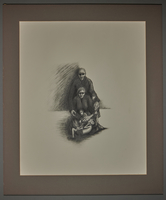
Drawing by Hannah Messinger of 2 women and 3 skeletal children
Object
One of a series of pencil drawings created around 1970 by Hannah Messinger based upon her experiences as an inmate in several concentration and labor camps from 1941-1945. It depicts a gaunt figure standing behind a kneeling woman and 3 children. In December 1941, Hannah, her husband Karel Kohorn, and her family were deported from German-occupied Prague to Theresienstadt labor camp. In mid-1942, Hannah had an abortion to avoid deportation to Poland. In September 1944, the family was deported to Auschwitz-Birkenau concentration camp. That January, Hannah was transferred to Sackisch and then Merzdorf forced labor camps. On May 8, 1945, the Soviet Army liberated the camp. Hannah walked to the Czechoslovak border where she collapsed; her friends took her to a hospital where she was placed in a crib because she only weighed 70 pounds and they thought she was a child. Upon her release, she returned to Prague and learned that all her family members were murdered. She evntually found relatives in Budapest and, through them, met Imre Messinger, a survivor of Soviet labor camps. Hannah emigrated to the United States on December 21, 1946, and Imre joined her in 1947.
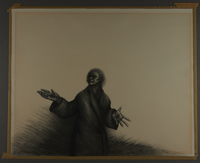
Drawing by Hannah Messinger of a woman gesturing in supplication
Object
One of a series of pencil drawings created around 1970 by Hannah Messinger based upon her experiences as an inmate in several concentration and labor camps from 1941-1945. It depicts an old woman gesturing with upraised arms. In December 1941, Hannah, her husband Karel Kohorn, and her family were deported from German-occupied Prague to Theresienstadt labor camp. Hannah had an abortion to avoid deportation to Poland. In September 1944, they were deported to Auschwitz-Birkenau concentration camp. That January, Hannah was transferred to Sackisch and then Merzdorf forced labor camps. On May 8, 1945, the Soviet Army liberated the camp. Hannah walked to the Czechoslovak border where she collapsed; her friends took her to a hospital where she was placed in a crib because she only weighed 70 pounds and they thought she was a child. Upon her release, she returned to Prague and learned that all her family members were murdered. Hannah emigrated to the United States on December 21, 1946.
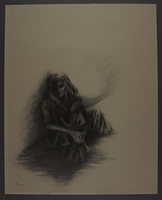
Drawing by Hannah Messinger of a cloaked woman and child slumped on a wall
Object
One of a series of pencil drawings created around 1970 by Hannah Messinger based upon her experiences as an inmate in several concentration and labor camps from 1941-1945. It depicts a cloaked woman slumped against a wall with a horribly thin child in her lap. In December 1941, Hannah, her husband Karel Kohorn, and her family were deported from German-occupied Prague to Theresienstadt labor camp. Hannah had an abortion to avoid deportation to Poland. In September 1944, they were deported to Auschwitz-Birkenau concentration camp. That January, Hannah was transferred to Sackisch and then Merzdorf forced labor camps. On May 8, 1945, the Soviet Army liberated the camp. Hannah walked to the Czechoslovak border where she collapsed; her friends took her to a hospital where she was placed in a crib because she only weighed 70 pounds and they thought she was a child. Upon her release, she returned to Prague and learned that all her family members were murdered. Hannah emigrated to the United States on December 21, 1946.
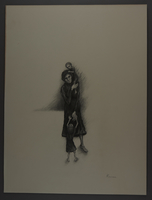
Drawing by Hannah Messinger of a woman with two emaciated children
Object
One of a series of pencil drawings created around 1970 by Hannah Messinger based upon her experiences as an inmate in several concentration and labor camps from 1941-1945. It depicts a woman with two emaciated children: one resting on her shoulder and a young girl reaching for her. In December 1941, Hannah, her husband Karel Kohorn, and her family were deported from German-occupied Prague to Theresienstadt labor camp. Hannah had an abortion to avoid deportation to Poland. In September 1944, they were deported to Auschwitz-Birkenau concentration camp. That January, Hannah was transferred to Sackisch and then Merzdorf forced labor camps. On May 8, 1945, the Soviet Army liberated the camp. Hannah walked to the Czechoslovak border where she collapsed; her friends took her to a hospital where she was placed in a crib because she only weighed 70 pounds and they thought she was a child. Upon her release, she returned to Prague and learned that all her family members were murdered. Hannah emigrated to the United States on December 21, 1946.
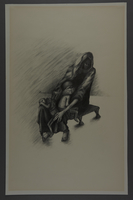
Drawing by Hannah Messinger of a woman holding 2 children on her lap
Object
One of a series of pencil drawings created around 1970 by Hannah Messinger based upon her experiences as an inmate in several concentration and labor camps from 1941-1945. It depicts a seated woman clasping two skeletal children. In December 1941, Hannah, her husband Karel Kohorn, and her family were deported from German-occupied Prague to Theresienstadt labor camp. Hannah had an abortion to avoid deportation to Poland. In September 1944, they were deported to Auschwitz-Birkenau concentration camp. That January, Hannah was transferred to Sackisch and then Merzdorf forced labor camps. On May 8, 1945, the Soviet Army liberated the camp. Hannah walked to the Czechoslovak border where she collapsed; her friends took her to a hospital where she was placed in a crib because she only weighed 70 pounds and they thought she was a child. Upon her release, she returned to Prague and learned that all her family members were murdered. Hannah emigrated to the United States on December 21, 1946.
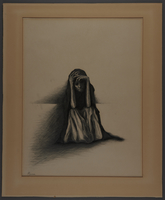
Drawing by Hannah Messinger of a woman sitting with her hands on her head
Object
One of a series of pencil drawings created around 1970 by Hannah Messinger based upon her experiences as an inmate in several concentration and labor camps from 1941-1945. It depicts an exhausted woman with her face collapsed in her hands. In December 1941, Hannah, her husband Karel Kohorn, and her family were deported from German-occupied Prague to Theresienstadt labor camp. Hannah had an abortion to avoid deportation to Poland. In September 1944, they were deported to Auschwitz-Birkenau concentration camp. That January, Hannah was transferred to Sackisch and then Merzdorf forced labor camps. On May 8, 1945, the Soviet Army liberated the camp. Hannah walked to the Czechoslovak border where she collapsed; her friends took her to a hospital where she was placed in a crib because she only weighed 70 pounds and they thought she was a child. Upon her release, she returned to Prague and learned that all her family members were murdered. Hannah emigrated to the United States on December 21, 1946.



